Making movies. Enjoying movies. Remembering movies.
THE BACKLOT
|
Posted December 6, 2004 |
|
Cruising The Streets Of L.A. An Interview With "Collateral" Stunt Driver Robert Nagle |
By
William Kallay
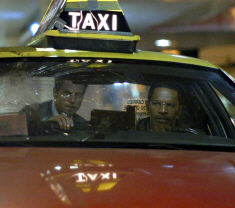
Last summer’s “Collateral” took audiences into the dark abyss of Los Angeles’ night life. Max (Jamie Foxx) is a taxi driver who picks up passenger Vincent (Tom Cruise). Max soon finds out that his passenger is a cold blooded hitman, and has essentially been taken hostage on his passenger’s melee.
Michael Mann’s film re-affirmed his precise directing-style of character study and slick action sequences as seen in “Heat” (1995). Using minimal action, Mann has made a film that is taut and exciting to watch.
There aren’t any car chases or explosions in “Collateral.” Much of the film takes place in Max’s taxicab, and most of the driving he does is, well, driving. So where does a stunt driver fit into the scheme of things?
Robert Nagle is a twelve-year veteran of precision stunt driving, and if you’ve seen the film, you’ve seen his work in action. At one point during “Collateral,” Max floors it and takes Vincent on a wild ride through the streets of downtown L.A. Some of the fast driving was performed by Jamie Foxx. He couldn’t have done it without the training from Nagle.
Nagle has worked on numerous television movies, commercials and films, including “3: The Dale Earnhardt Story” (2004) and the upcoming “Herbie: Fully Loaded” (2005). His background also includes modifying cars for film and commercial shoots, and he has competition licenses in the SCCA, USAC, and IMSA organizations.
Robert and I recently spoke about his work on “Collateral,” precision stunt driving, and cars.
William Kallay, From Script To DVD: How did you become involved with “Collateral”?
Robert Nagle: I’ve worked on a couple of other projects previously with Michael Mann. I also worked directly with Michael with somes racing by instructing him personally. And we had also built a car for him, and then took him up to the track and got him up-to-speed in that car. It became a natural. Anytime there’s driving involved, he picks up the phone and calls me.
FSTD: Have you done any stunts before this?
Nagle: Yes. I do a lot of TV car commercials, some TV show and some features.
FSTD: How did you meet Michael Mann?
Nagle: Actually, he was trying to complete the car that we built for him. It was a 1970 Chevelle that was just way “out-of-control.”
[laughter]
It was basically turned into a 1970 Chevelle put on top of a Winston Cup suspension/chassis with about 700-horsepower.
FSTD: Oh my gosh.
Nagle: It’s quite a ride.
FSTD: Does he drive this car in competition?
 |
|
Robert Nagle |
Nagle: No, it’s a street car. We’ve taken it to the track with him for him to enjoy. He can run it around Willow Springs and have some fun with it and really open it up.
FSTD: 700-horsepower and it’s still street legal?
Nagle: Yes. It doesn’t get very good gas mileage.
FSTD: Does it take special fuel?
Nagle: It was built pretty conservatively. It runs on pump gas.
FSTD: I would think that a car like that would require special fuel at a race track.
Nagle: You can make horsepower by increasing the compression ratio of the motor. In lieu of that, we substituted cubic inches. It’s 540-cubic inches, but fairly conservative compression so that you can still run pump gas in it. If you wanted more power out of this, you can certainly do that, but then you have to put in exotic fuels and it’s not so fun to drive.
FSTD: Most of the driving in the film is subtle, but there’s a scene in which Jamie Foxx careens around downtown L.A. Did he perform most of the driving in that sequence?
Nagle: It’s not an easy question to answer. He did a lot of the driving, but if you look at it, there’s a lot of dialogue in that sequence. Michael and I spent some time trying to figure how we would get Jamie to drive at speed and do the dialogue. There are portions of it where he’s driving. There are portions where he’s not driving. We shot so much of that, I couldn’t even tell you at the end of the day what-was-what in the film. So, yes, there are definitely sections where he is driving. But when the dialogue becomes really heavy, then his focus has to come back to acting, which is what he does. In those situations, it’s better not to have him behind the wheel.
FSTD: Was the car on a rig during dialogue scenes, or was Jamie actually driving?
Nagle: For the high-speed sequence, we couldn’t really put it on a rig. There’s a section of road that’s too narrow for the trailer and rig to tow a car around. We put Jamie in the car with the camera and sent him on his way. That was one scenario. The other scenario was that we had another car that we built with a “blind drive” system, where I doubled for Tom Cruise and sat in the backseat of the car and actually drove the car from that position. We put Jamie in the front. That was another set-up we did.
FSTD: Did you have a few cars that were rigged specifically for scenes like that?
 |
Nagle: Yes. The blind drive car was built specifically for that sequence.
FSTD: Watching the movie, I couldn’t even tell what was going on. It looked like everything was live-action. In some movies, if you look really closely, there’s a stuntman taking the place of the actor, and you can tell he’s got the wig on and the suit and it doesn’t work quite right. But in “Collateral,” it was seamless.
Nagle: If you know Michael’s work at all, he’s very meticulous about being realistic. It can’t look fake. It can’t look “Hollywood.”
FSTD: What kind of driving experience did Foxx bring to the film? Had he done any high-performance driving before?
Nagle: He really had not. We worked with him. I spent two days working with him, getting him to drive at speed, starting with just basics of how a car handles. What makes it stick to the road? How your inputs to the car affect it and what the car tells you; what the car’s about to do and how to control that. So we spent two solid days working on that. He picked it up really well. He’s really able to focus himself and really take it in. I was really impressed by that.
FSTD: Where did you train?
Nagle: Up at Willow Springs Racetrack, just north of Lancaster [outside of Los Angeles].
FSTD: Did you practice in a car that was similar to the taxi?
Nagle: No. We had two [Ford] Crown Victorias up there that were basically identical to the [camera cars]. And we had them rigged with roll bars in them so they’d be safe. We just spent two solid days driving these cars. Typically, we’ll be on the track for half-hour, come off the track, and we’ll talk about what went on and what the next steps are for the building blocks to continue on. Then we’ll take a fifteen minute break. It’s a lot more physical than people realize. And going back to what you were asking about the car. As far as trying to compress the time and get the most quality time and training out of it, it’s important to use the same vehicle, because the characteristics are much different from vehicle-to-vehicle.
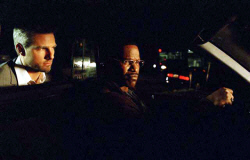 |
FSTD: Did he come out of this wanting to continue high-performance driving?
Nagle: Yes. He had actually mentioned to me that when things slowed down for him, he wanted to go out and do this again. He really enjoyed it.
FSTD: Is he a car collector?
Nagle: He’s got some cars. I don’t think that’s a big focus for him, but he does have some cars.
FSTD: How do you go about training somebody that’s never precision driven?
Nagle: We start at just a basic level of how a car functions, the vehicle dynamics, what makes it work and how to work with it. There’s a lot of learning and unlearning your basic skills. Your brain tells you to do the wrong thing when a car is at its limit of adhesion. It’s training someone to not do what their natural reaction is. We slowly build up to that so that you can see how your inputs affect the vehicle, what to feel for, so you understand what the vehicle is doing. It’s not going to tell you everything that’s going on. It’s really working just from little tiny building blocks of handling characteristics, and building that up to where you’re up to almost to the level of what the vehicle is capable of.
FSTD: Were the Crown Victorias modified beyond having safety harnesses and roll bars? Was the suspension changed to make the car more maneuverable for you?
Nagle: The suspension was left stock. The only cars that had a roll bar were the ones we used for training, and, of course, the car that they turned over at the end of the sequence. Other than that, they just had standard seatbelts and airbags.
FSTD: Are the Crown Vics fun to maneuver? Ford builds those specifically for police forces around the country.
Nagle: They’re big and lethargic.
[laughter]
FSTD: It’s not quite like a Mustang, where it’s a smaller car with tighter suspension and smaller body mass.
Nagle: It’s a lot more work to get these cars around the corner at any kind of speed. Little cars, like Mustangs, are much faster through corners.
FSTD: How do you adjust when you’re taking a tight corner?
Nagle: It’s not that simple. One of the things I’ve always brought to the table is that I’ve got a big racing background. That allows me to really drive a car fast. There’s a lot of setting the car up as you’re going into a corner. [If you don’t] get the right amount of weight on the front wheels, and you get it to turn too much, the back wheels lose traction. It’s a fine balance of getting the car entered into a corner, and basically, it’s sliding all the way through the corner. It may not look like it, but to really get some speed, all four wheels are drifting through the corner.
FSTD: Are you also working the brakes and the accelerator at the same time?
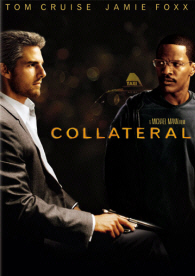 |
Nagle: Yes. Your steering, your throttle and brake are all involved in that. It’s not quite as simple as coming up to the corner real fast and turning the wheel. It’s almost like a ballet of just getting the car balanced right on the edge of that adhesion.
FSTD: Do you take practice runs?
Nagle: Typically, yes. What I’ll do is, once we have a course laid out, I’ll run the course at, say, 50% of what I feel the car is capable of. I get a feel for what the road conditions are like. And I may make one more run at 90%. Then I can give them some input on where a camera should be, what’s a safe area, what might happen here, what might happen there. I’m looking for feedback from the director at that time as far as vehicle placement and speed. But typically one run through and I’m ready to go.
FSTD: Once you get the script, do you sit down with the director and coordinate how the stunts are going to go? Or is it a mixture between the script and what Michael Mann sees?
Nagle: With Michael, it’s all up to him.
[laughter]
He’ll tell me what he’s looking for and look to me for feedback if that’s possible. But he’ll definitely express exactly what he wants.
FSTD: Have you worked with other directors who may not have as much experience with stunts?
Nagle: Yes. If they’re not as familiar with vehicles, we try and work with them and explain to them that this is possible, that is not possible. We can do X. We can do Y, and give them some options and just guide them through it. At the end of the day, it’s their vision and we try and accommodate that.
FSTD: Do you have a crew that directly works with you?
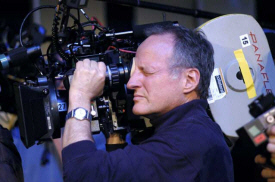 |
|
Director Michael Mann |
Nagle: We have a fabrication shop we build cars like this for. There are a handful of drivers that I work with.
FSTD: Do you occasionally pass the stunt on to one of your drivers, or do you handle them mostly on your own?
Nagle: I try to do as much as I can. If there’s a chase scene involved where we have multiple drivers, then I’d certainly bring them on, because they’re guys I’ve worked with closely and we know what each other driver is capable of and what they’re going to do. Because when you’re running at speeds that close, you really need to trust the other guy.
FSTD: You had mentioned that you have a fabrication shop. Do you actually rig up the cars that are in the movie you’re working on? Or are those handled by somebody else?
Nagle: We do a lot of car preparation for film. For “Collateral,” we built the car with the blind drive system.
FSTD: How long would it take to build a car like that?
Nagle: We probably have 50 man-hours in it.
FSTD: What kind of safety equipment would you put into a car?
Nagle: On a basic level, we want a good safety restraint system/seatbelt system. If the factory one isn’t sufficient enough, then we go to a racecar harness system, which is a five-point harness. The next level above that would be a simple roll hoop, or roll bar that just goes up over the driver to protect the roof from coming in on him. And the next step beyond that would be a roll cage, which is more of an enclosure inside the vehicle.
FSTD: Do you still have the standard air bags inside the car, or would you have to disable them?
Nagle: If we know that we’re going to crash the car, we typically disable them.
FSTD:
Why is that?
Nagle:
Once we have our restraint systems in there, the airbags can become a
little bit more of a hazard. They’re designed to catch an occupant in a
frontal impact, but we don’t want it. We don’t need added things going off
in the car. The restraint systems that we put in are more than adequate to
restrain somebody. It keeps them safe.
FSTD: You’re basically building a modified race car when you’re doing this, aren’t you?
Nagle: In a sense, yes.
FSTD: During a stunt, is it easier for you to maneuver a smaller car, like a Mustang Cobra, or a larger vehicle like the taxicab in “Collateral”? What are some of the limitations of each car?
Nagle: The bigger cars, like the Crown Victoria, are just really cumbersome. They’re really slow to respond to your inputs with steering and braking and throttle, versus a Mustang Cobra which is a lot crisper. The feedback from the car is more precise. It handles way better than the Crown Victoria
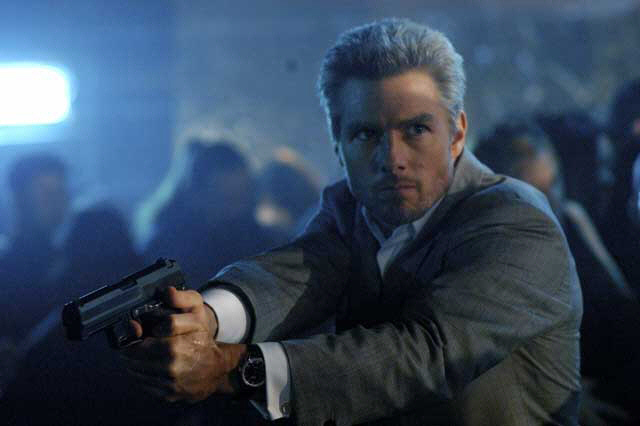 |
does. We’re able to carry a lot more speed with a bigger margin of safety with a car that already handles better.
FSTD: Can you tell me about your involvement in the Sports Car Club Of America [SCCA]?
Nagle: I still race periodically through SCCA. I have a national and professional racing license. I was heavily involved with SCCA in the mid-1990s. Prior to that, I was learning how to road race. It’s a good organization. It’s a great place to get your feet wet. There are so many different kinds of car classes to race in. You kind of pick and choose based on your budget where it fits in for you. And they have competitive racing from regional levels in Southern California to a national level where you can compete all over the U.S.
FSTD: Have you raced mostly in modified (Mustang) Cobras?
Nagle: A good part of it has been that. I’ve raced different Formula cars. Some “spec racing Fords.” It’s a purpose-built car with a stock motor in them. It’s more or less a level playing field and it’s more up to the driver and less about the car. I’ve run some of their pro endurance races. Endurance racing is really enjoyable, where you’re running six hours, four hours or twelve hours.
FSTD: How has stunt driving changed with use of digital technology?
Nagle: It’s changing.
[laughter]
There’s a lot of work now where they’re using plate shots and CGI, where normally we would have a stunt driver in the car. They’re beginning to manipulate things where unfortunately, it may not be necessary. It’s an issue. It really is.
FSTD: I know someone who does stunts, and he says it’s been kind of hard lately because of the fact that either reality shows are cutting into action shows on TV, or computerized stuntmen are getting into the picture.
Nagle: There have been some car commercials I’ve done, one of which featured Winston Cup cars. We only had three cars on the track, and lo and behold, there were six or seven!
FSTD: How did you become involved in racing cars?
Nagle: On a whim, a friend of mine said, “Hey, why don’t take this car around the track and see what you think.” It’s been “downhill” since. It was really addictive to me. I really enjoyed it. I really enjoyed the level of focus required and the competitiveness. It really fed into what I’m about. I love it.
Special Thanks to Robert Nagle and Dorrit Ragosine
Artwork & Images © DreamWorks, LLC. All rights reserved
